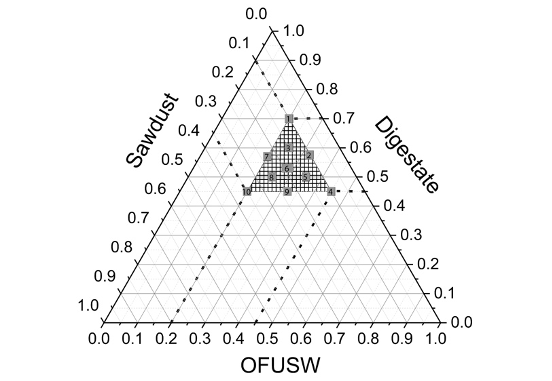 |
|
A biosolid was produced from the composted digestate of the organic fraction of urban solid wastes (OFUSW). During a first hydrolytic-acidogenic stage, the milled OFUSW mass is transformed into volatile fatty acids and other soluble or suspended substances in the leachate while the residual solids constitute the digestate.
A biosolid was produced from the composted digestate of the organic fraction of urban solid wastes (OFUSW). During a first hydrolytic-acidogenic stage, the milled OFUSW mass is transformed into volatile fatty acids and other soluble or suspended substances in the leachate while the residual solids constitute the digestate. To obtain a composting mass (CM) with a C/N between 25 and 35 and a matrix to allow aeration, mixtures of digestate (fD), OFUSW (fF) and sawdust (fS) were prepared using a simplex centroid design. Results were adjusted to a multiple regression model with volatile solids degradation efficiency (ηVS) as a response variable. It was found that the operation zone with the highest ηVS, were CM with the following compositions: fD: 0.425-0.625, fF: 0.275-0.450; and fS: 0.1-0.15. Three assays were carried out in a bench scale reactor, the final biosolids had a pH = 7.5, a C/N = 15 and a germination index (GI) = 84%. A linear correlation between ηvs and CO2 production was proposed for process control. A rapid CM stabilization was reached, up to ηVS = 35% in 12 days and the biosolids with high GI, can be used to improve soils.
Keywords: Anaerobic digestion; composting matrix; simple centroid design; biosolids; temperature; C/N ratio.
|
|
 |

